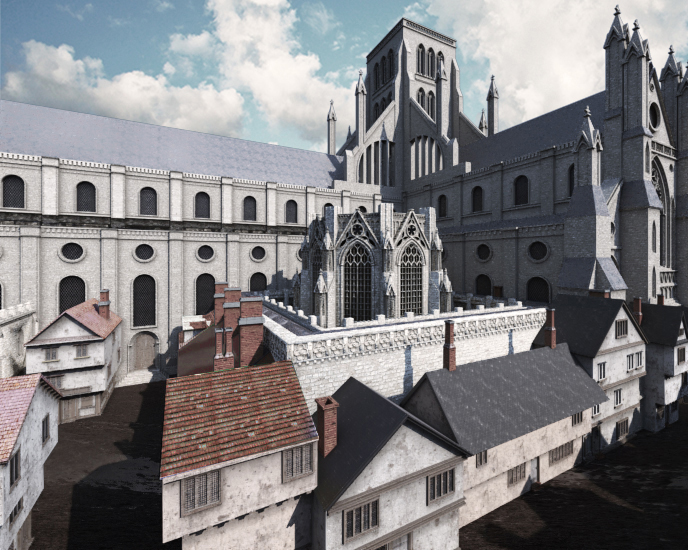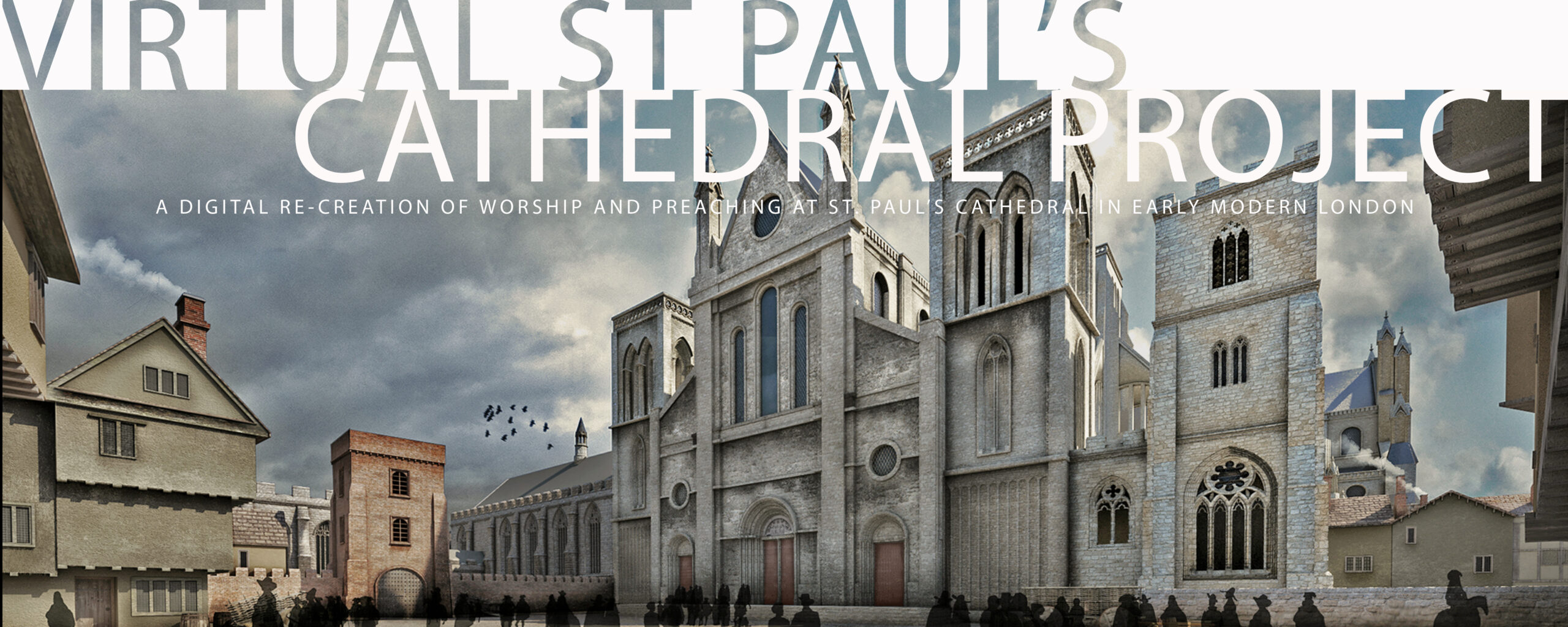The staff of St Paul’s Cathedral during Donne’s tenure as Dean included a number of professional musicians, both lay and ordained, as well as a significant number of skilled laborers — including bell-ringers, grave-diggers, and custodians — whose work was essential to the larger functioning of the Cathedral’s life as the largest church building in London and the center of administration and worship for the Diocese of London.
Donne also had members of his personal staff who also held posts at the Cathedral, including the post of Dean’s Verger and Cathedral Librarian.
This section of the Virtual St Paul’s Cathedral website brings together basic information we now know of these people, including their names, their terms of service, and their duties. Most lived in the Cathedral’s Churchyard. While Cathedral records document the comings and goings of the clergy and musicians, for those with more labor-intensive jobs, Donne’s writings — and especially his will — serve as primary sources.
The College of Minor Canons
Membership of the College of Minor Canons, also known as Petty Canons, consisted of 12 priests who served as singers and musicians. They shared with the Vicars Choral and the Choir Boys the work of preparing and performing the choral parts of the Daily Offices of Morning and Evening Prayer, as well as other services of the week and Church Year.
In their sole as musicians, the members of the College of Minor Canons and the Vicars Choral sang the bass, tenor, and counter-tenor (alto) parts, while the Choirsters sang the treble (or soprano) parts.
Members of the College of Minor Canons lived on the north side of St Paul’s and dined communally in the Hall of Minor Canons also located in Paul’s Churchyard north of the Cathedral’s Nave.
These twelve men were called Minor Canons or Petty Canons to distinguish them from the official Canons of the Cathedral. The Cathedral’s Canons were priests who constituted the Cathedral’s Chapter. Unlike the Canons, the Minor Canons were not supported by income from specific tracts of land owned by the Cathedral.
There were formal rites for installing the various officers of the Cathedral.
The Rite for Installation of a Minor, or Petty, Canon in use in the early 1660’s — and therefore likely to be the same Rite in use prior to the Civil War — was as follows:
I. N. Subdean, or A.B. Succentor of this Cathedral Church of S. Paul, London, doe by virtue of a Mandate and Power given me from the Dean and Chapter of the said Church induct and install you, N. or C.D. into the reall, actuall, and corporall possession of Senior Cardinall, second Prebend and Minor Canonship founded in this Cathedrall Church, with all the rights, profits, and emoluments belonging to the same. In the name of the Father, and of the Sonne, and of the Holy Ghost. Amen.
Let us pray.
O Lord save Thy servant.
Answer. Which putteth his trust in Thee.
Send him helpe from Thy holy place.
Answer. And evermore mightily defend him.
Let the enemy have noe advantage of him.
Answer. Nor the wicked approach to hurt him.
Be unto him O Lord a strong Tower.
Answer. From the face of the enemy.
O Lord hear our prayer.
Answer. And let our cry come unto Thee.
O God, the Author and Finisher of all good things, the Giver of all grace, and the most bountifull Rewarder of all good workes, we beseech the infinite aboundance of Thy goodness, by the merits and intercession of Thy Sonne Jesus Christ, to grant to this Thy servant N. who by Thy good providence Thou hast brought into our number and fraternity, soe religiously to serve Thee in this Thy house, and soe to converse with his brethren in true charity, that after the course of this present life finished, he may by Thy mercie obtaine the crowne of everlasting life, throw Jesus Christ our Lord, to Whom with Thee and the Holy Ghost be honour and glory world without end. Amen.
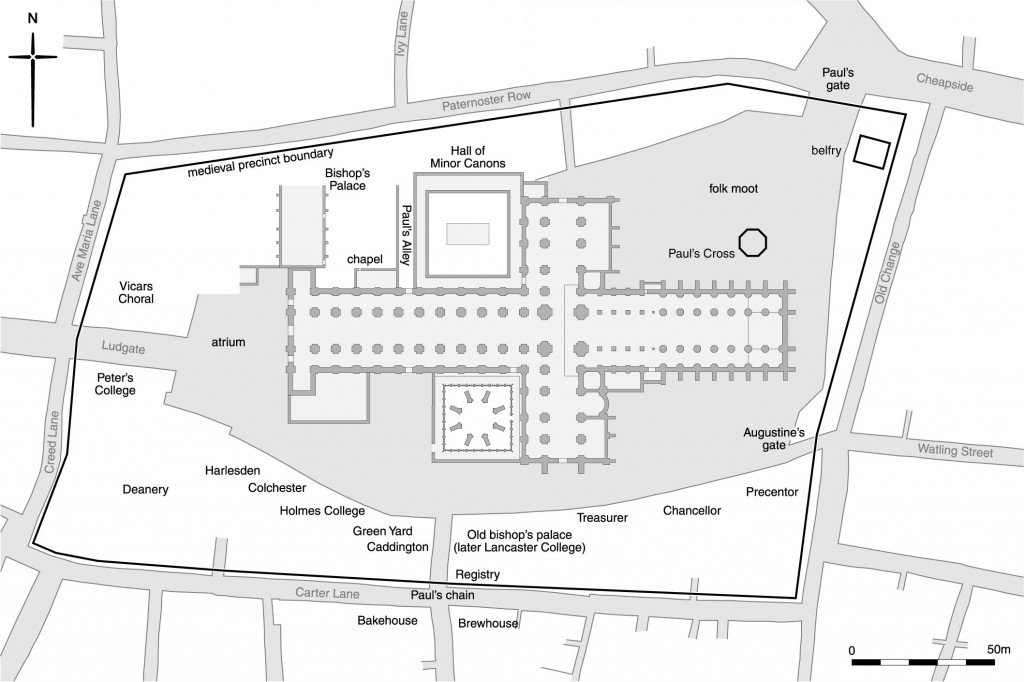
St. Paul’s Churchyard around 1450. Image courtesy John Schofield, from St Paul’s Cathedral Before Wren (2011)
The Vicars Choral
The Vicars Choral were professional musicians who were laymen, not clergy. There were places for six Vicars Choral on the staff of the Cathedral in Donne’s day, although the actual number varied from time to time, as the information presented below will show. The Vicars Choral shared with the Minor Canons and the Choir Boys the work of preparing and performing the choral parts of the Daily Offices of Morning and Evening Prayer, as well as other services of the week and Church Year.
The Vicars Choral lived communally on the west side of Paul’s Churchyard, north of Ludgate Street.
Members of the College of Minor Canons during Donne’s tenure as Dean included the following:
Vicars Choral at St Paul’s Cathedral during Donne’s tenure included the following:
The Sub-Dean — Matthew Roydon (until 1625), then Luke Jones (1626 – 1627), then Rowland Jennings (from 1628 until after Donne’s death)
The Senior Cardinal, or Second Minor Canon — Thomas Langley (until 1630), then John Thurgood (1631 until after Donne’s death)
The Junior Cardinal, or Third Minor Canon — John Thurgood (served throughout Donne’s tenure, promoted to Senior Cardinal position in 1631), then Thomas Maycock (appointed 1631)
Minor Canon #4 — William Fry (until 1623), then John Barnard (from 1623). Barnard would later assemble musical scores from the Cathedral’s library, from which he would publish the First Book of Selected Church Musick (London, 1641).
Minor Canon #5 — Roger Nighingale (throughout Donne’s tenure)
Minor Canon #6 — John Wyborough (throughout Donne’s tenure)
Minor Canon #7 — Thomas Lugg (until 1626), then Enos Williams (until 1627), then Zacharias Griffin (from 1627)
Minor Canon # 8 — Luke Jones (until 1627), then Nicholas Pownell (from 1628)
Minor Canon # 9 — Simon Stubbs (until 1622; also served as Rector of St Gregory’s Parish Church), then John Farnaby (from 1626 until 1629), then Zacharias Griffin (from 1629)
Minor Canon # 10 — Thomas Maycock (throughout Donne’s tenure)
Minor Canon # 11 — Robert Huggins (until 1627), then Ralph Mansbridge (from 1627)
Minor Canon # 12 — Rowland Jennings (until 1629), then Giles Barrowes (from 1629)
In his will, Donne bequeathed forty shillings to each of the Minor Canons and Vicars Choral.
William Wyles (until 1625 or 1626)
Peter Hopkins (until 1625 or 1626)
William Cranford (throughout Donne’s tenure)
John Tomkins (throughout Donne’s tenure)
Edward Colbrand (until 1624 or 1625)
John Woodington (from 1622)
Richard Sandy (from 1624 or 1625)
Adrian Batten (from 1626)
William Morgan ( from 1624 or 1625)
Martin Peerson (from 1626)
According to the Cathedral’s Account Books (which recorded the full roster of Vicars Choral each time a property belonging to the College of Vicars Choral was leased), the line-up of Vicars Choral during Donne’s tenure was as follows:
As of June 14th, 1621 — Wiles, Hopkins, Cranford, Tompkins, Colbrand
As of April 30th, 1624 — Wiles, Hopkins, Cranford, Tompkins, Colbrand, Woodington
As of June 23rd, 1624 — Wiles, Hopkins, Cranford, Tompkins, Colbrand, Woodington
As of December 19th, 1626 — Cranford, Tompkins, Woodington
As of December 22nd, 1628 — Cranford, Tompkins, Woodington, Sandy, Batten, Morgan
As of July 2nd, 1629 — Cranford, Tompkins, Woodington, Sandy, Batten, Morgan
As of December 7th, 1632 — Cranford, Tompkins, Woodington, Sandy, Batten, Morgan
The Master of the Choristers
The Master of the Choristers was responsible for assembling and rehearsing the group of ten boys who sang the treble (soprano) parts in choral services. At St Paul’s the role of the Almoner (a member of the Cathedral staff who distributed alms to the needy) was joined to the role of Master of Choristers.
The Master of the Choristers at St Paul’s shared with his colleagues at Westminster Abbey, the Chapel Royal at the Palace of Westminster, and St George’s Chapel at Windsor Castle the authority to “take up” (recruit) Choristers from the choirs of collegiate churches and provincial cathedrals across England to join the Choirs at their respective institutions.
Masters of the Choristers during Donne’s tenure as Dean of the Cathedral included John Gibbs (until 1624) and Martin Peerson (from 1624).
The Choristers
The Choristers were the ten boys who sang the high (treble or soprano) parts in choral works performed in worship services at the Cathedral. In Donne’s day, boys did not go through puberty as early as they do today, so most of the Choristers could have been as old as 16 or 17.
The Choristers lived with the Master of the Choristers in the Almoner’s House on the south side of the Cathedral, along the alley that ran between the Chapter House and the rear of St Gregory’s Church.
In his will, Donne bequeathed forty shillings to the Master of the Choristers and an additional forty shillings to be distributes to the Choristers.

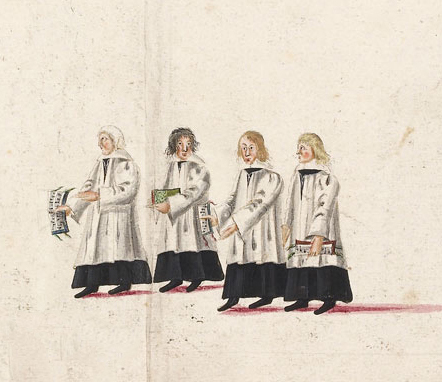
Choristers vested for performance. Image courtesy British Library.
Organists
Organists at St Paul’s Cathedral during Donne’s tenure included John Tomkins (throughout Donne’s tenure), Adrian Batten (from 1626), and Martin Peerson (from 1626).
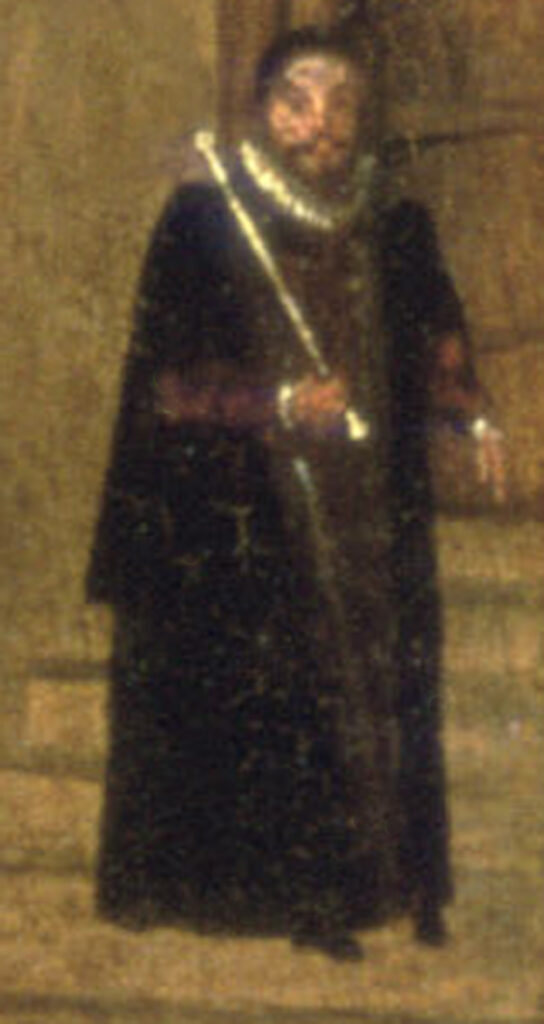
John Gipkyn, St Paul’s Verger (Detail of Dr King preaching at Old St Paul’s before James I). Image courtesy Society of Antiquaries of London, UK
Vergers
In his will, Donne bequeathed thirty shillings to each of the Vergers, who were traditionally responsible for the care of church buildings as well as helping to plan the details of worship services, leading the procession of ministers from the Vesting Room to the site of the worship service, and shepherding clergy through their movements within the service. At least in some cases, vergers were also responsible for the grave-diggers carrying out their responsibilities.
Vergers did their jobs best when they did them well but inconspicuously. During worship services, the verger on duty for a given service wore a distinctive gown and carried the “virge,” or staff of his office. A Verger at work at St Paul’s Cathedral is included in John Gipkin in his famous painting of a Paul’s Cross sermon, standing inconspicuously behind the Preaching Station, having led the procession of officiants out to the Station from the Cathedral and waiting now to lead them back to the Cathedral when the sermon was done.
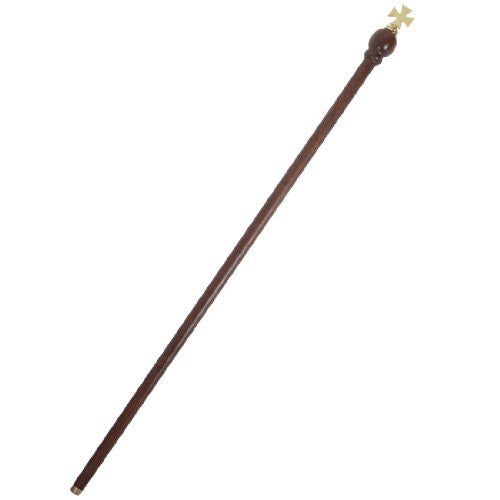
A virge used by Vergers today. Image courtesy Wikimedia Commons.
Recent research by Mary Ann Lund of the University of Leicester tells us that in Donne’s tenure as Dean there were four vergers on staff. In addition to their basic responsibilities for ensuring the orderly life and worship of the cathedral, Lund has found that they were also charged with “guarding the church and opening and closing its doors daily, keeping order among the visitors and worshippers, and working under the sacrist and laying out vestments.”
Records of the Cathedral have enabled Lund to identify two possible names of the four vergers on duty during Donne’s time as Dean. One certainly was — as of January 23rd, 1623, Robert Christmas, a member of Donne’s personal staff, was appointed senior verger at St Paul’s. The second name — that of Gerrard Powell — does not appear in Cathedral records until 1634 but may have taken up his post as verger before then.
Interestingly, both Christmas and Powell appear in the Cathedral records because they were receiving an additional payment of £5 “for and in regard of their paynes formerly taken for the accommodacion of the Lord Maior and Aldermen in the said Church every sunday and every other tyme of their repaire thether,” a comment that helps us identify at least one group of people other than the Cathedral’s clergy and musicians who attended worship at St Paul’s on Sundays.
Librarians
The Library of St Paul’s Cathedral was built alongside the west face of the North Transept, just visible in this bird’s-eye view.

Mary Ann Lund’s research documents Thomas Roper’s tenure as Cathedral Librarian from April 3rd, 1626 until he was replaced by Robert Christmas in that post on December 19th, 1626. Christmas held this post throughout the remainder of Donne’s Deanship, as well as through the tenure of Thomas Winniffe, Donne’s successor as Dean.
Organ Bellows Operators
The Cathedral maintained a sizeable group of people whose job was to pump the bellows during worship services and practice sessions so that the organist could play his instrument.
Bell Ringers
In his will, Donne bequeathed twenty shillings to each of the Bell Ringers. So far, their names are lost to us.
Personal Staff
The various households of the Bishop of London and the resident officials of the Cathedral all had staffs of servants who cooked, cleaned, dressed, washed, and maintained the stables of horses and carriages. They also had staffs to support their professional activities. The size of these staffs is difficult to estimate, but the evidence of Donne’s will provides us with some clues.
In his will, Donne left £10 to Vincent his coachman and to John Christmas, his servant. He left an additional £5 to his “faithful” servants Robert Christmas and Thomas Roper, designted as “officers of the Churche of St Paule.” For more on Roper as Cathedral Librarian, see above. For more on Christmas as Christmas as a member of Donne’s personal household, in addition to his duties as the Dean’s Verger and Cathedral Librarian, see above. Donne also left to £20 to Elizabeth, a maid who attended to Donne’s daughters. He left £5 to Thomas Moore, described as a “younge boye whome [he] tooke lately . . . in my service.” He also left to “other” maidservants and manservants ‘a yeares wages over & above that which shalbe due to them.”
All this adds up to a staff of at least 6 people sufficiently important to be named, plus a number of “other” manservants and maidservants large enough to be listed in the plural.
